Influences of Efficient Spraying of Cement-Based Slurries on Recycled Coarse Aggregate
Abstract
1. Introduction
2. Materials and Methodology
2.1. RCA
2.2. Cement
2.3. Silica Fume
2.4. RCA Treatment Methods
2.5. CV Test
2.6. WA Test and DWA Test
2.7. AD Test
2.8. Micro-Morphology Analysis
3. Results and Discussion
3.1. Slurry Absorption
3.2. AD
3.3. CV
3.4. WA
3.5. DWA
3.6. Discussion
4. Conclusions
- A batch spraying method, using cement-based slurry, was proposed to treat the RCA. Based on the slurry absorption, when the flow rate was 5 g/(s∙kg), the RCA was basically saturated within three spraying cycles, and the slurry and time required were about 5% of the mass of the RCA and 1 min, respectively;
- The strength of the RCA was improved regardless of the treatment method and the W/B of the slurry. The CV decreased by up to 30% when the spraying method was used with a W/B of 0.7. When the SF was incorporated, the crushing value of the RCA could be further decreased;
- The WA of the RCA decreased with the increase in the W/B. To decrease the WA of the RCA, the W/B should be no less than 1.0. The WA decreased by up to 14.3% when the spraying method was used with a W/B of 1.3. With the incorporation of the SF, the WA of the RCA showed an obvious increase regardless of the treatment method;
- The DWA test showed that the water absorption rate was very rapid, and the evolution of the water absorption was not affected by the spraying treatment or the immersing treatment using cement-based slurry. When the RCA entered the water, the saturation degree reached more than 50%. After about 9–15 min, the saturation degree of the RCA reached more than 90%;
- In terms of the CV, WA and AD, the effects of the spraying method and the immersing method were basically equivalent. When the spraying method was used, only about 1 min and a small amount of slurry (about 5% of the RCA mass) were required to treat the RCA. It was recommended that pure cement slurry should be used and the W/B should be 1.3 when the spraying method was adopted to treat the RCA, and the comprehensive grade could be enhanced from III to II.
Author Contributions
Funding
Data Availability Statement
Conflicts of Interest
References
- Zhao, J.; Zhang, B.; Xie, J.; Wu, Y.; Wang, Z.; Liu, P. Effects of nano-SiO2 modification on rubberised mortar and concrete with recycled coarse aggregates. Nanotechnol. Rev. 2022, 11, 473–496. [Google Scholar] [CrossRef]
- Yazdani, M.; Kabirifar, K.; Frimpong, B.E.; Shariati, M.; Mirmozaffari, M.; Boskabadi, A. Improving construction and demolition waste collection service in an urban area using a simheuristic approach: A case study in Sydney, Australia. J. Clean. Prod. 2021, 280, 124138. [Google Scholar] [CrossRef]
- Jike, N.; Xu, C.; Yang, R.; Qi, Y.; Dai, Y.; Peng, Y.; Wang, J.; Zhang, M.; Zeng, Q. Pervious concrete with secondarily recycled low-quality brick-concrete demolition residue: Engineering performances, multi-scale/phase structure and sustainability. J. Clean. Prod. 2022, 341, 130929. [Google Scholar] [CrossRef]
- Verma, A.; Sarath Babu, V.; Arunachalam, S. Influence of mixing approaches on strength and durability properties of treated recycled aggregate concrete. Struct. Concr. 2021, 22, E121–E142. [Google Scholar] [CrossRef]
- Zhang, J.; Li, S.; Zhai, J. Grey Prediction Model for Drying Shrinkage of Cement Concrete Made from Recycled Coarse Aggregate Containing Superabsorbent Polymers. Math. Probl. Eng. 2021, 2021, 6662238. [Google Scholar] [CrossRef]
- Younis, K.H.; Mustafa, S.M. Feasibility of using nanoparticles of SiO2 to improve the performance of recycled aggregate concrete. Adv. Mater. Sci. Eng. 2018, 2018, 1512830. [Google Scholar] [CrossRef]
- Caneda-Martínez, L.; Monasterio, M.; Moreno-Juez, J.; Martínez-Ramírez, S.; García, R.; Frías, M. Behaviour and properties of eco-cement pastes elaborated with recycled concrete powder from construction and demolition wastes. Materials 2021, 14, 1299. [Google Scholar] [CrossRef]
- Kim, D.; Kwon, K.; Kim, G.; Choi, H. Evaluation of Korean recycled aggregates as backfilling underground power system considering particle breakage effect. J. Mater. Cycles Waste Manag. 2021, 23, 1665–1677. [Google Scholar] [CrossRef]
- Xiao, J.; Lu, D.; Ying, J. Durability of recycled aggregate concrete: An overview. J. Adv. Concr. Technol. 2013, 11, 347–359. [Google Scholar] [CrossRef]
- Adessina, A.; Fraj, A.B.; Barthélémy, J.F.; Chateau, C.; Garnier, D. Experimental and micromechanical investigation on the mechanical and durability properties of recycled aggregates concrete. Cem. Concr. Res. 2019, 126, 105900. [Google Scholar] [CrossRef]
- Kim, J. Influence of quality of recycled aggregates on the mechanical properties of recycled aggregate concretes: An overview. Constr. Build. Mater. 2022, 328, 127071. [Google Scholar] [CrossRef]
- Fang, X.; Zhan, B.; Poon, C.S. Enhancement of recycled aggregates and concrete by combined treatment of spraying Ca2+ rich wastewater and flow-through carbonation. Constr. Build. Mater. 2021, 277, 122202. [Google Scholar] [CrossRef]
- Mehrabi, P.; Shariati, M.; Kabirifar, K.; Jarrah, M.; Rasekh, H.; Trung, N.T.; Shariati, A.; Jahandari, S. Effect of pumice powder and nano-clay on the strength and permeability of fiber-reinforced pervious concrete incorporating recycled concrete aggregate. Constr. Build. Mater. 2021, 287, 122652. [Google Scholar] [CrossRef]
- Bui, N.K.; Satomi, T.; Takahashi, H. Enhancement of recycled aggregate concrete properties by a new treatment method. GEOMATE J. 2018, 14, 68–76. [Google Scholar] [CrossRef]
- Li, L.; Xu, P.; Zhu, Y.; Yan, H.; Li, H. Constitutive relationship of strengthened recycled coarse aggregate concrete under uniaxial compression. J. Xi’an Univ. Arch. Technol. 2020, 52, 717–724. [Google Scholar]
- Sadagopan, M.; Malaga, K.; Nagy, A. Improving Recycled Aggregate Quality by Mechanical Pre-Processing. Materials 2020, 13, 4342. [Google Scholar] [CrossRef] [PubMed]
- Liu, A. Experimental Study on Performance of Asphalt Mixture Strengthened by Coarse Recycled Concrete Aggregate. Master’s Thesis, Yangzhou University, Yangzhou, China, 2020. [Google Scholar] [CrossRef]
- Kim, H.S.; Kim, B.; Kim, K.S.; Kim, J.M. Quality improvement of recycled aggregates using the acid treatment method and the strength characteristics of the resulting mortar. J. Mater. Cycles Waste Manag. 2017, 19, 968–976. [Google Scholar] [CrossRef]
- Saravanakumar, P.; Manoj, D.; Jagan, S. Properties of concrete having treated recycled coarse aggregate and slag. Rev. Construcción 2021, 20, 249–258. [Google Scholar] [CrossRef]
- Li, L.; Xuan, D.; Sojobi, A.O.; Liu, S.; Chu, S.H.; Poon, C.S. Development of nano-silica treatment methods to enhance recycled aggregate concrete. Cem. Concr. Compos. 2021, 118, 103963. [Google Scholar] [CrossRef]
- Ying, J.; Han, Z.; Shen, L.; Li, W. Influence of parent concrete properties on compressive strength and chloride diffusion coefficient of concrete with strengthened recycled aggregates. Materials 2020, 13, 4631. [Google Scholar] [CrossRef]
- Liu, S.; Shen, P.; Xuan, D.; Li, L.; Sojobi, A.; Zhan, B.; Poon, C.S. A comparison of liquid-solid and gas-solid accelerated carbonation for enhancement of recycled concrete aggregate. Cem. Concr. Compos. 2021, 118, 103988. [Google Scholar] [CrossRef]
- He, Z.; Shen, A.; Wu, H.; Wang, W.; Wang, L.; Guo, Y. Properties and mechanisms of brick-concrete recycled aggregate strengthened by compound modification treatment. Constr. Build. Mater. 2022, 315, 125678. [Google Scholar] [CrossRef]
- Zeng, W.; Zhao, Y.; Zheng, H.; sun Poon, C. Improvement in corrosion resistance of recycled aggregate concrete by nano silica suspension modification on recycled aggregates. Cem. Concr. Compos. 2020, 106, 103476. [Google Scholar] [CrossRef]
- Zhang, J.; Li, C.; Ding, L.; Zhao, H. Performance evaluation of strengthening recycled coarse aggregate in cement stabilized mixture base layer of pavement. Adv. Civ. Eng. 2020, 2020, 8821048. [Google Scholar] [CrossRef]
- Hu, H.B.; He, Z.H.; Fan, K.J.; Shibro, T.G.; Liu, B.J. Properties enhancement of recycled coarse aggregates by pre-coating/pre-soaking with zeolite powder/calcium hydroxide. Constr. Build. Mater. 2021, 286, 122888. [Google Scholar] [CrossRef]
- Martirena, F.; Castaño, T.; Alujas, A.; Orozco-Morales, R.; Martinez, L.; Linsel, S. Improving quality of coarse recycled aggregates through cement coating. J. Sustain. Cem. Based Mater. 2017, 6, 69–84. [Google Scholar] [CrossRef]
- Cao, F.; Wei, Z.; Wang, C.; Liu, L.; Ni, L.; Tian, J. Effects of Rice Husk Ash and Metakaolin Admixture on the Properties of Recycled Concrete. Ind. Constr. 2021, 51, 167–171. [Google Scholar] [CrossRef]
- Du, T.; Li, H.Q.; Wu, X.G. Experimental study on strengthening concrete recycled aggregate. New Build. Mater. 2002, 29, 6–8. [Google Scholar]
- Zhang, H.; Xu, X.; Su, S.; Zeng, W. To improve the resistance of recycled aggregate concrete (RAC) to the internal steel corrosion by the pre-treatment of aggregate. Constr. Build. Mater. 2021, 306, 124911. [Google Scholar] [CrossRef]
- Shaban, W.M.; Yang, J.; Su, H.; Liu, Q.F.; Tsang, D.C.; Wang, L.; Xie, J.; Li, L. Properties of recycled concrete aggregates strengthened by different types of pozzolan slurry. Constr. Build. Mater. 2019, 216, 632–647. [Google Scholar] [CrossRef]
- Liu, T.; Wang, Z.; Zou, D.; Zhou, A.; Du, J. Strength enhancement of recycled aggregate pervious concrete using a cement paste redistribution method. Cem. Concr. Res. 2019, 122, 72–82. [Google Scholar] [CrossRef]
- Zhang, H.; Zhao, Y.; Meng, T.; Shah, S.P. Surface treatment on recycled coarse aggregates with nanomaterials. J. Mater. Civ. Eng. 2016, 28, 04015094. [Google Scholar] [CrossRef]
- Santos, W.F.; Quattrone, M.; John, V.M.; Angulo, S.C. Roughness, wettability and water absorption of water repellent treated recycled aggregates. Constr. Build. Mater. 2017, 146, 502–513. [Google Scholar] [CrossRef]
- Deng, X.L.; Yu, A.P.; Huang, Z.W. Experimental study and analysis on physical and mechanical properties of sea sand and river sand mortar. Concrete 2021, 43, 112–116. [Google Scholar]
- Li, J.; Xiao, H.; Zhou, Y. Influence of coating recycled aggregate surface with pozzolanic powder on properties of recycled aggregate concrete. Constr. Build. Mater. 2009, 23, 1287–1291. [Google Scholar] [CrossRef]
- Jin, B.-H.; Song, M.-Y.; Xie, X.; Cao, X.-C. Study on Mechanical Properties and Resistance to Chloride Ion Permeability of Self-compacting Concrete with Pre-grouted Recycled Aggregate. China Concr. Cem. Prod. 2021, 48, 97–100. [Google Scholar]
- Belin, P.; Habert, G.; Thiery, M.; Roussel, N. Cement paste content and water absorption of recycled concrete coarse aggregates. Mater. Struct. 2014, 47, 1451–1465. [Google Scholar] [CrossRef]
- Piasta, W.; Zarzycki, B. The effect of cement paste volume and w/c ratio on shrinkage strain, water absorption and compressive strength of high performance concrete. Constr. Build. Mater. 2017, 140, 395–402. [Google Scholar] [CrossRef]
- Yang, Q. Research and Application of Water Absorption of Cement-Based Materials. Master’s Thesis, Tsinghua University, Beijing, China, 2021. [Google Scholar]
- Wang, J.; Xue, S.; Zhang, P.; Li, C.; Gao, S. Effect of Air Entraining Agent on Microstructure and Capillary Water Absorption of Mortar Before and After Freeze-thaw Cycles. J. Build. Mater. 2022, 25, 1–14. [Google Scholar]
- Yang, Y. Influence of Recycled Aggregate Strengthen and Adding Fiber on the Properties of Recycled Aggregate Concrete. Master’s Thesis, Beijing Jiaotong University, Beijing, China, 2014. [Google Scholar]
- Eckert, M.; Oliveira, M. Mitigation of the negative effects of recycled aggregate water absorption in concrete technology. Constr. Build. Mater. 2017, 133, 416–424. [Google Scholar] [CrossRef]
- Zhang, H.; Ji, T.; Liu, H.; Su, S. Improving the sulfate resistance of recycled aggregate concrete (RAC) by using surface-treated aggregate with sulfoaluminate cement (SAC). Constr. Build. Mater. 2021, 297, 123535. [Google Scholar] [CrossRef]
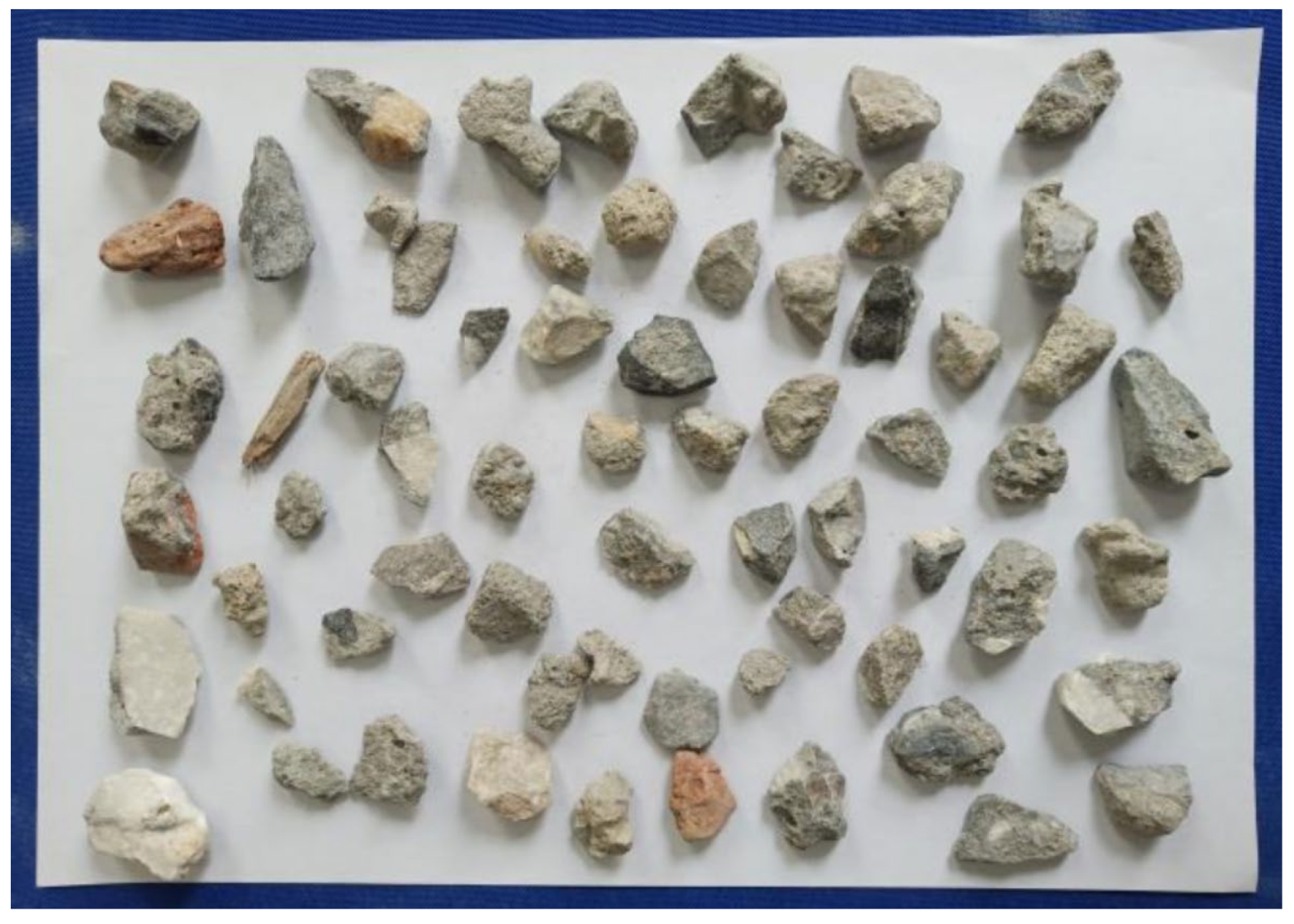
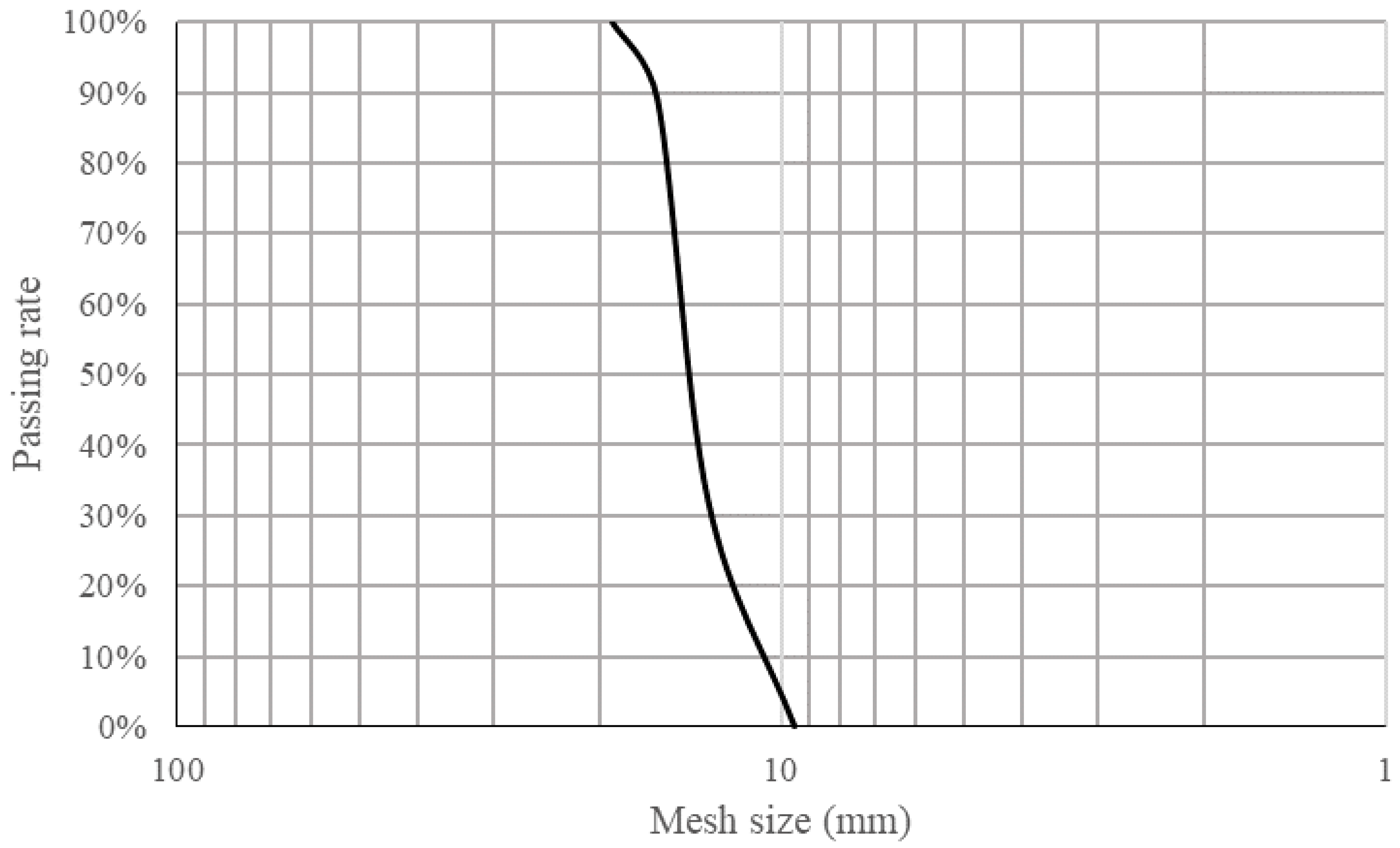
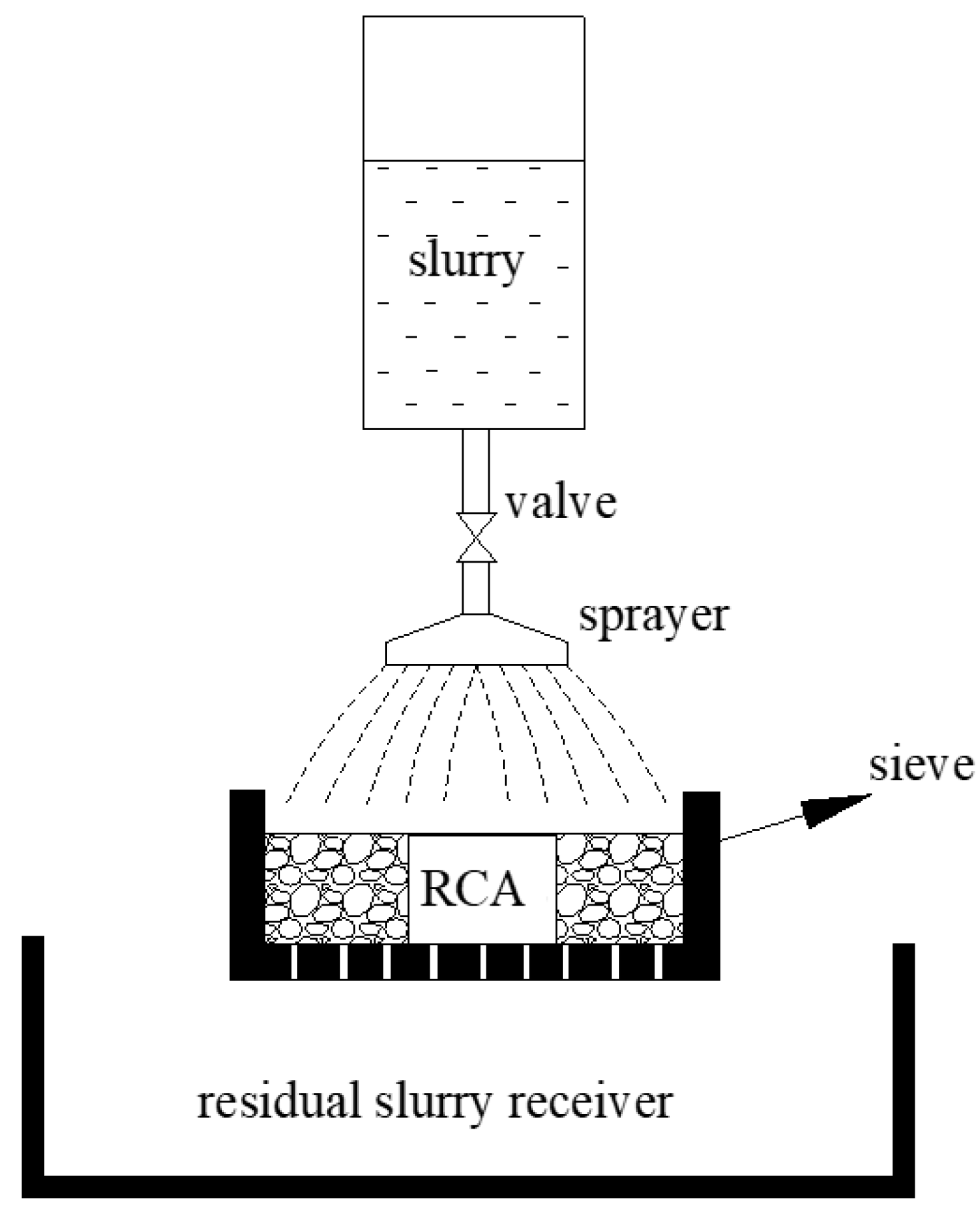

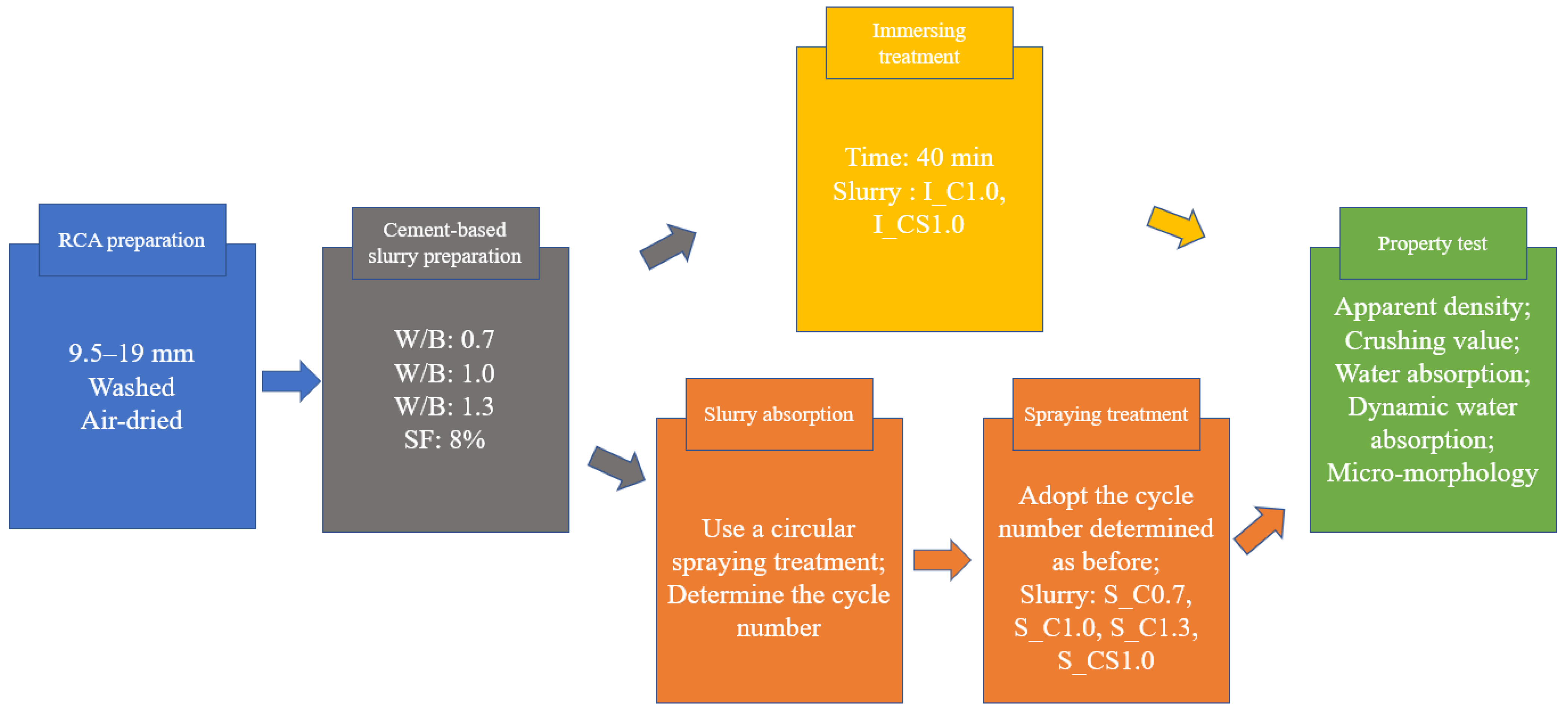
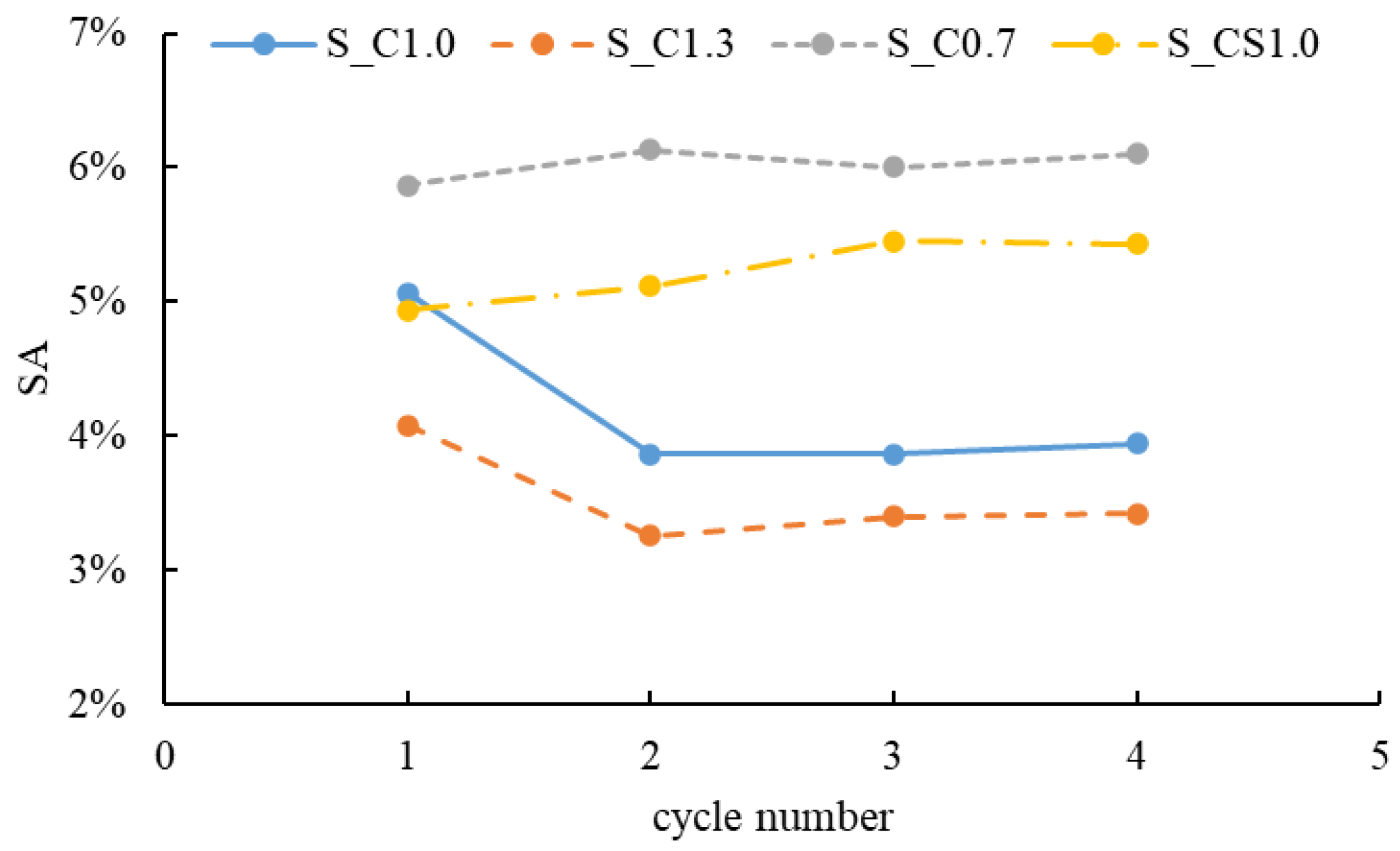
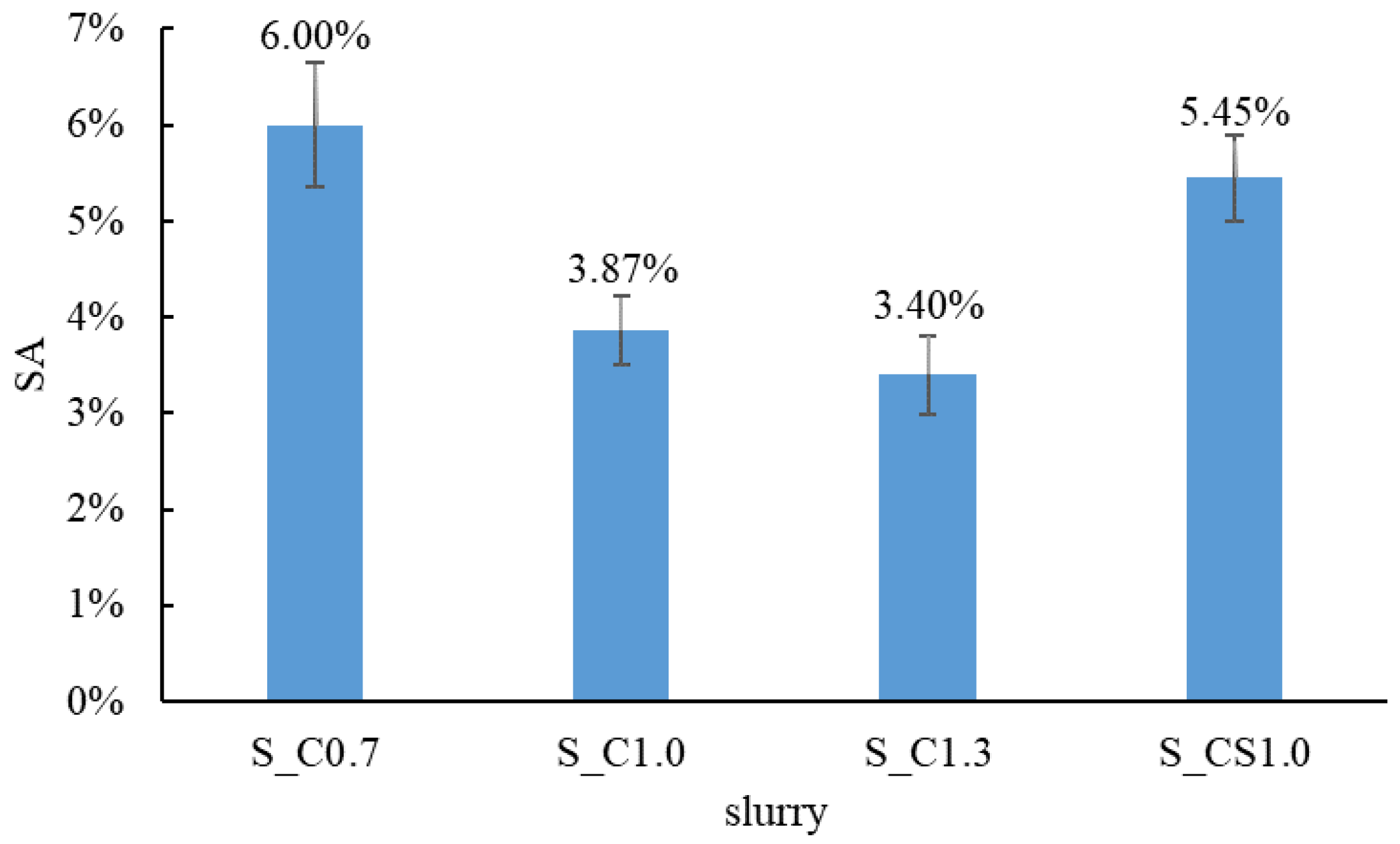
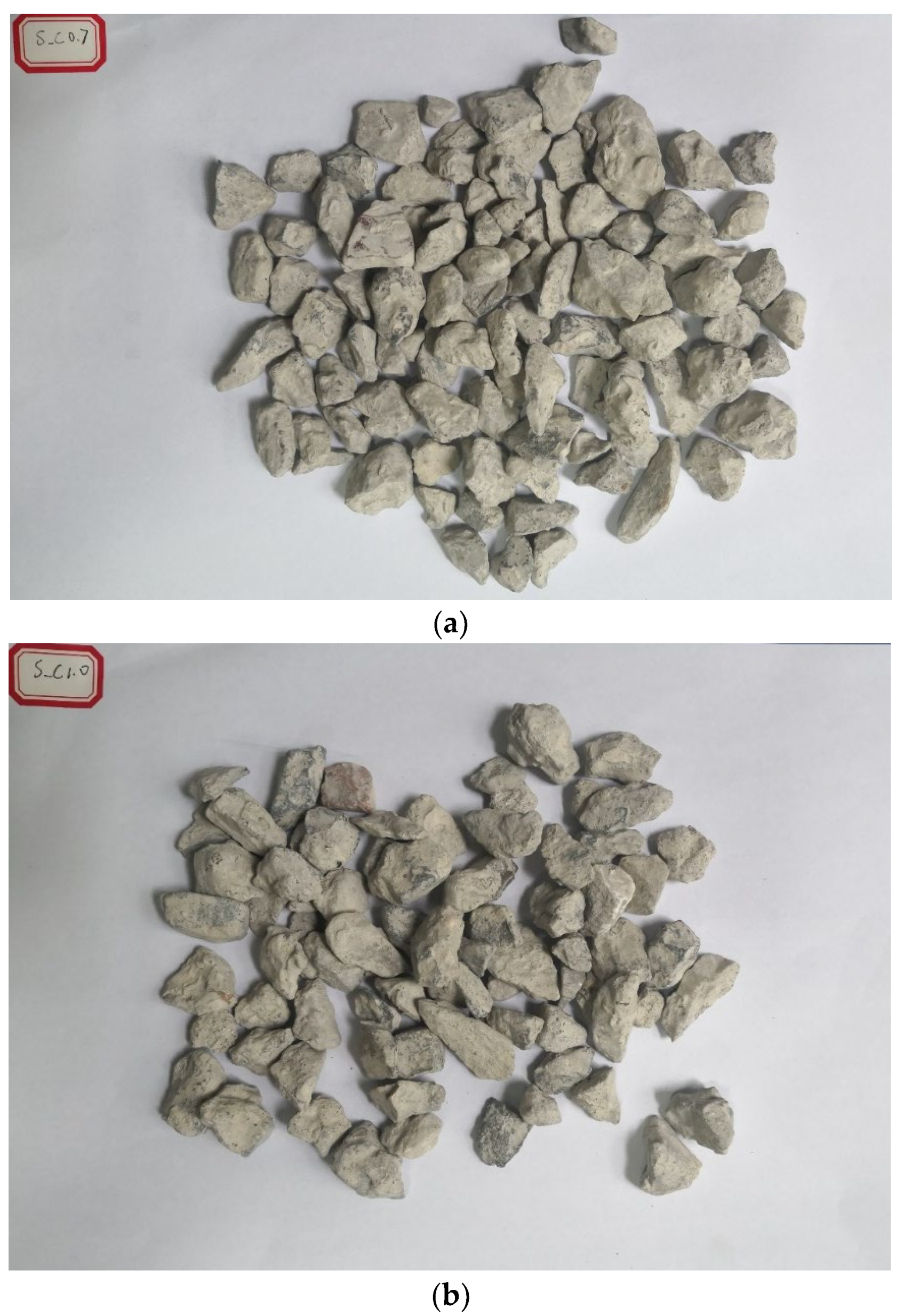
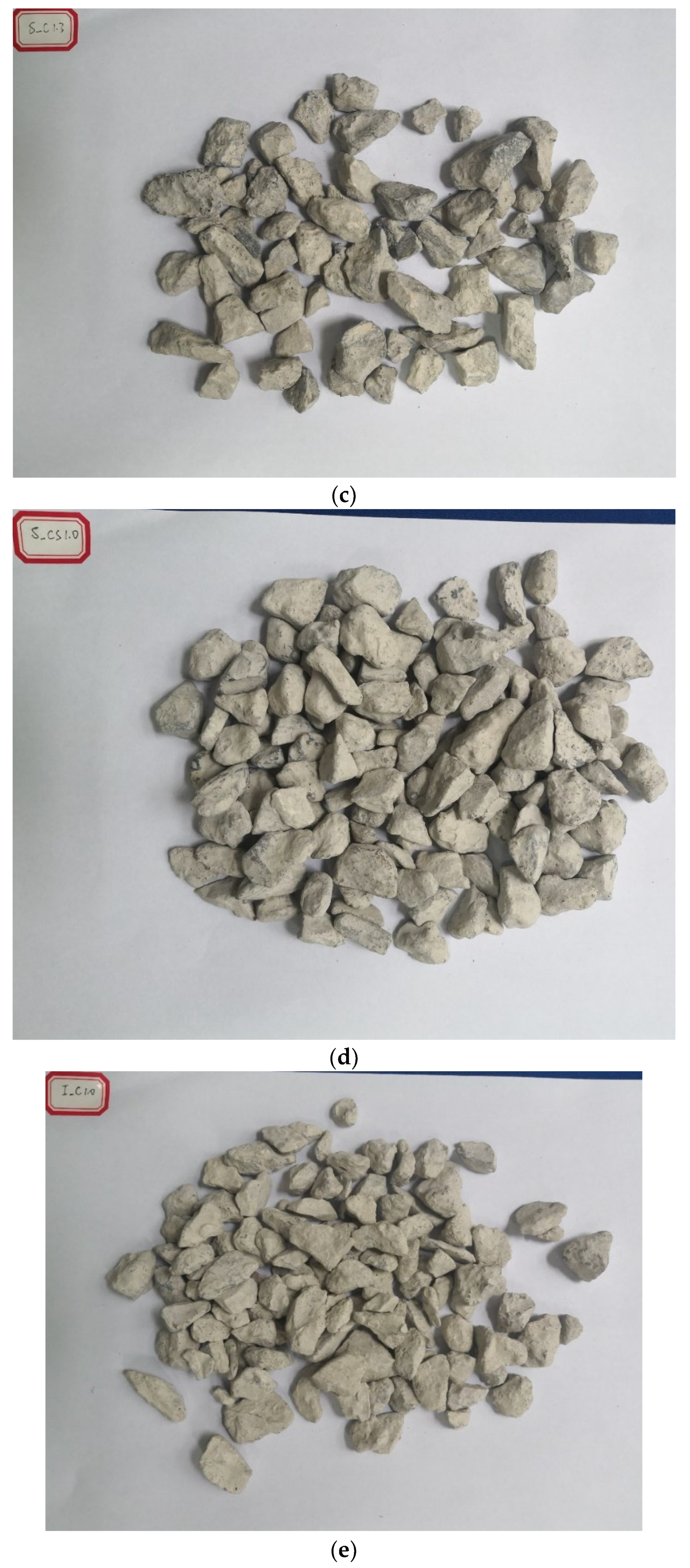
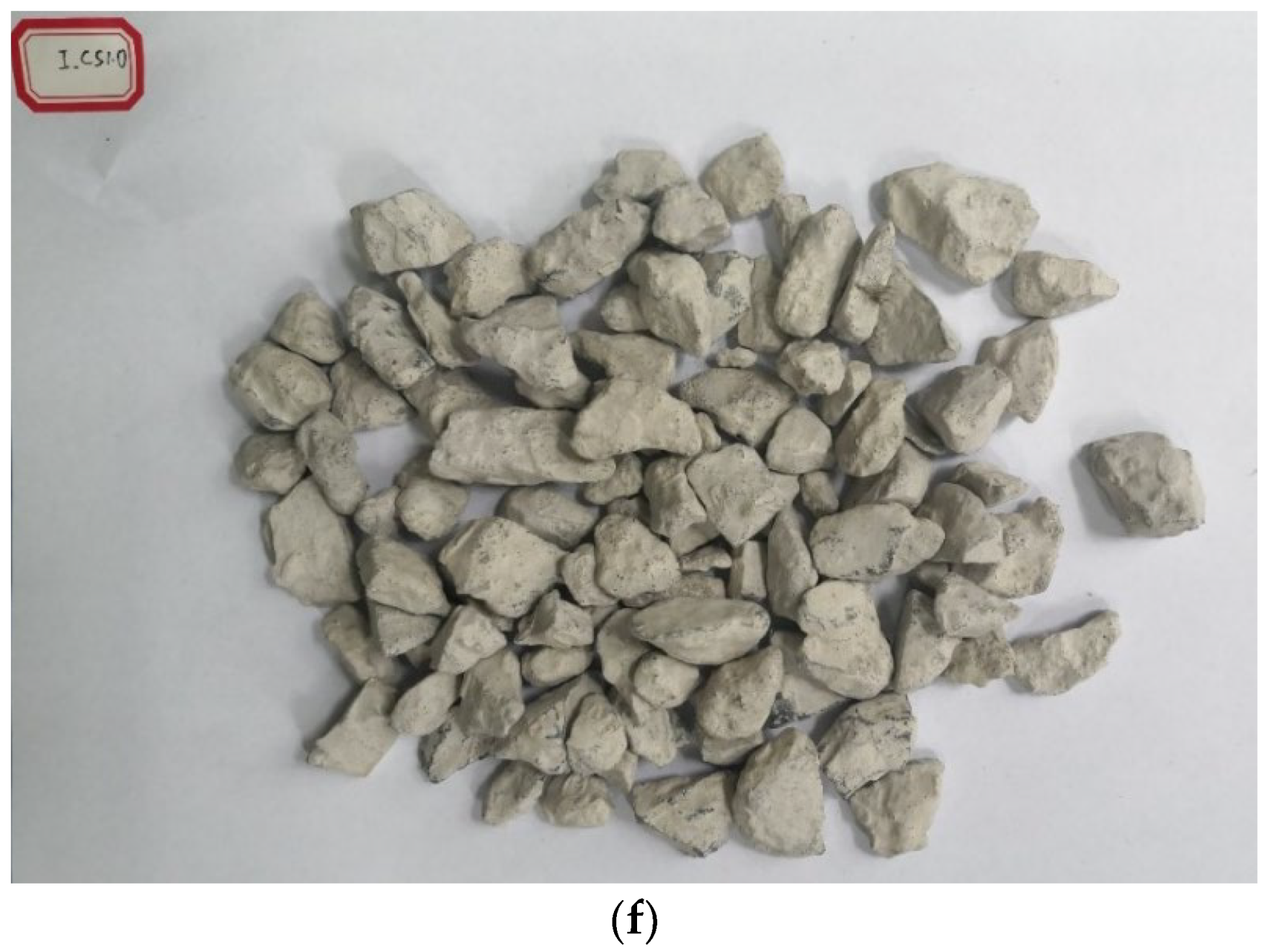
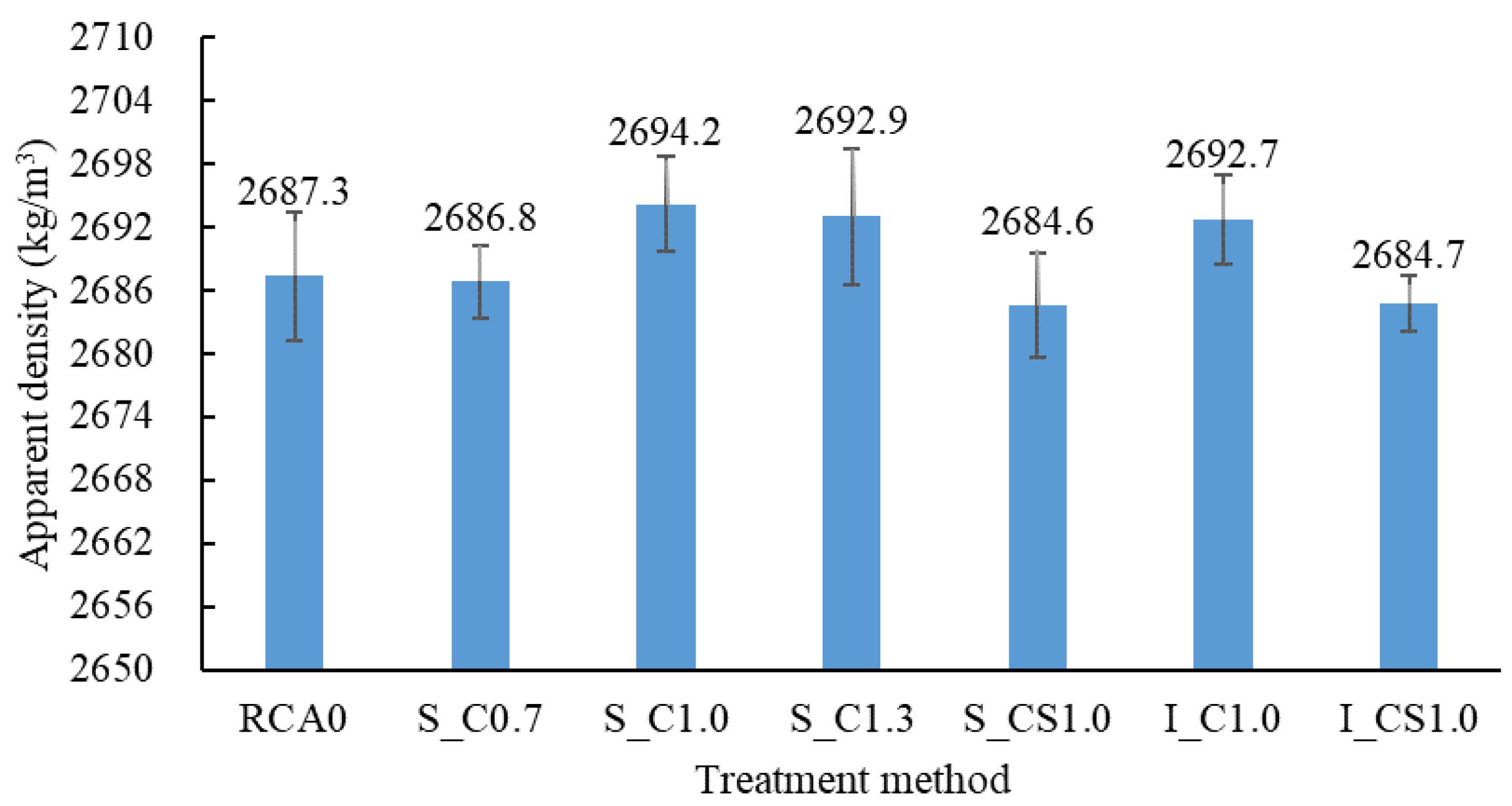
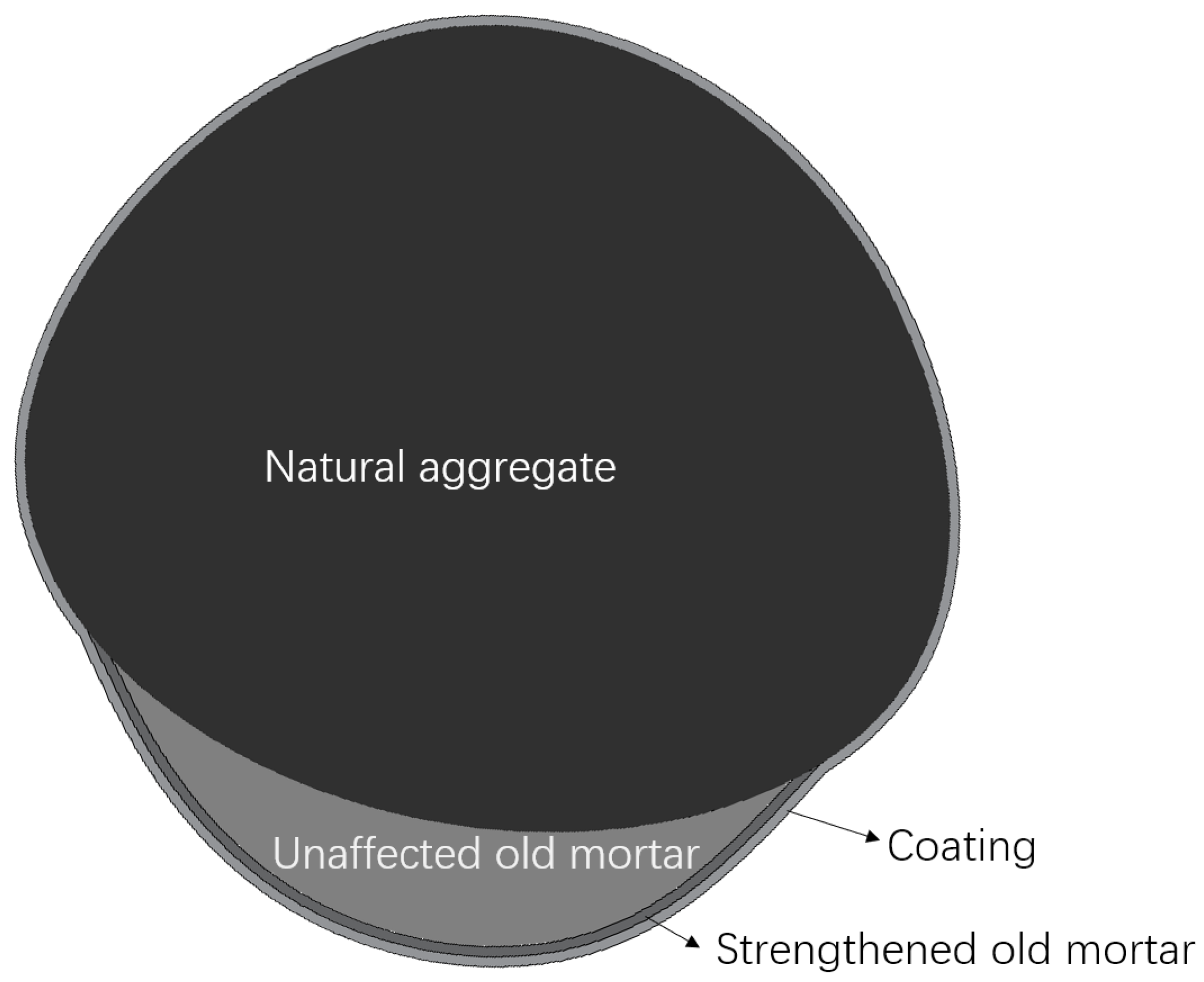



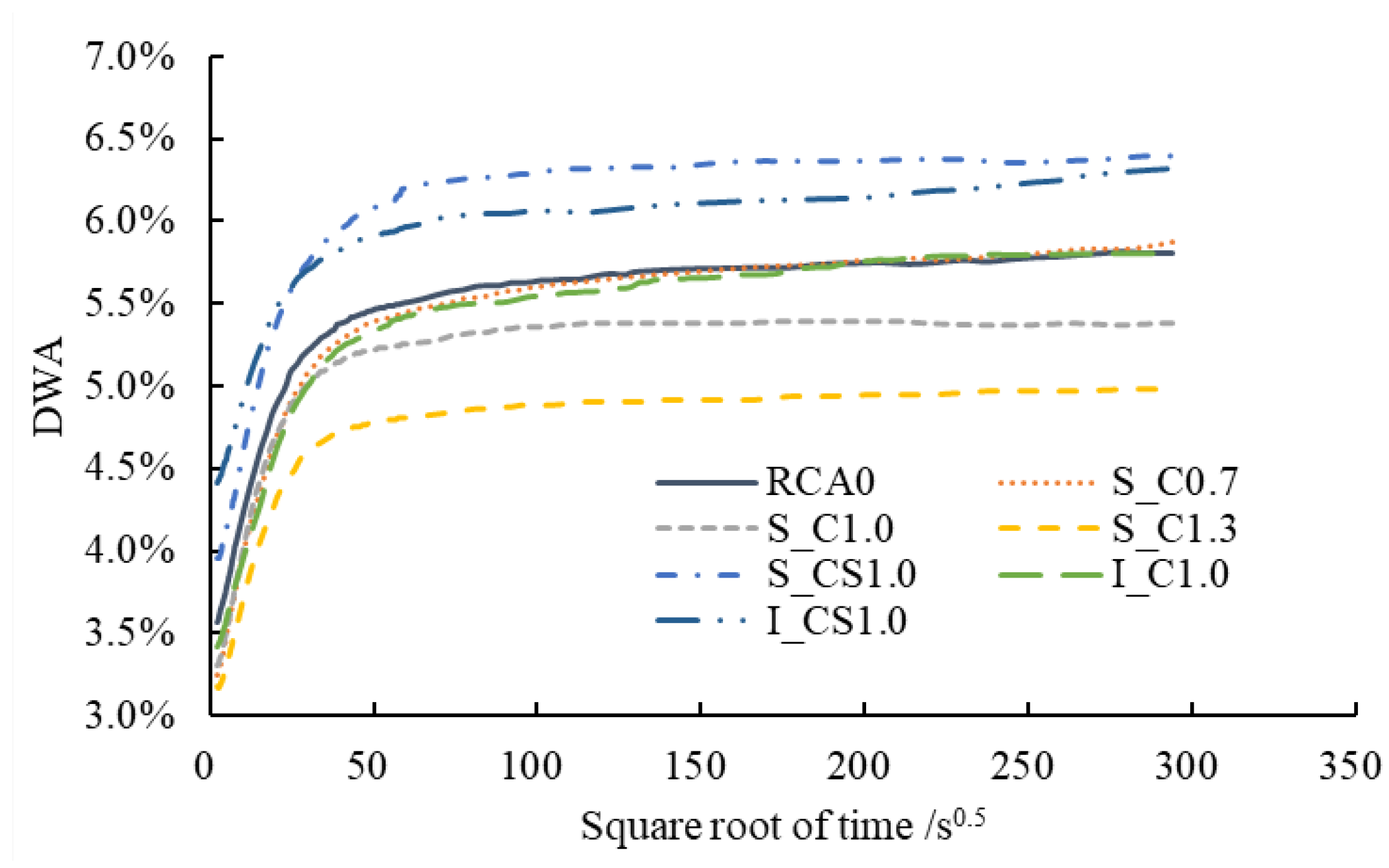
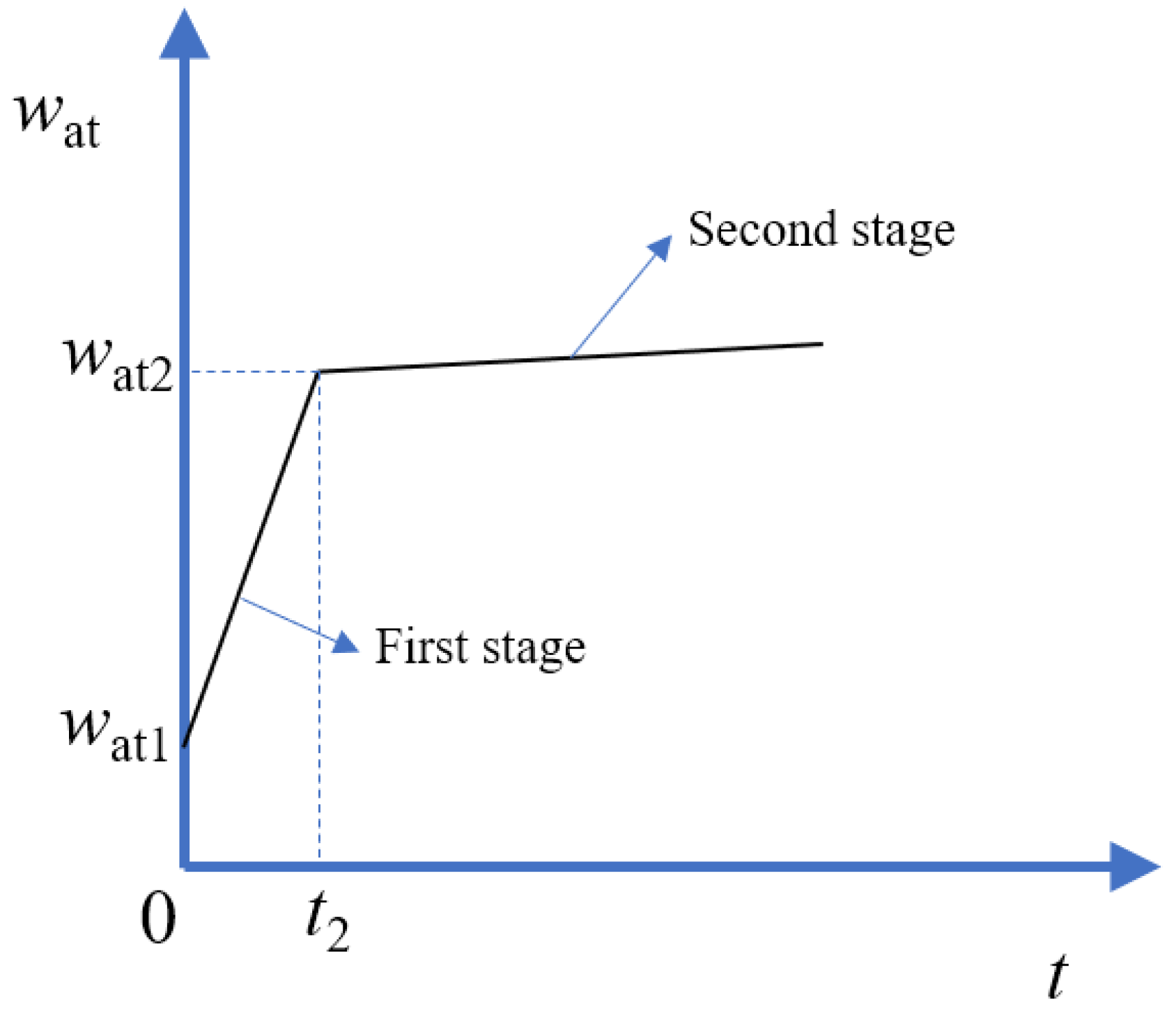
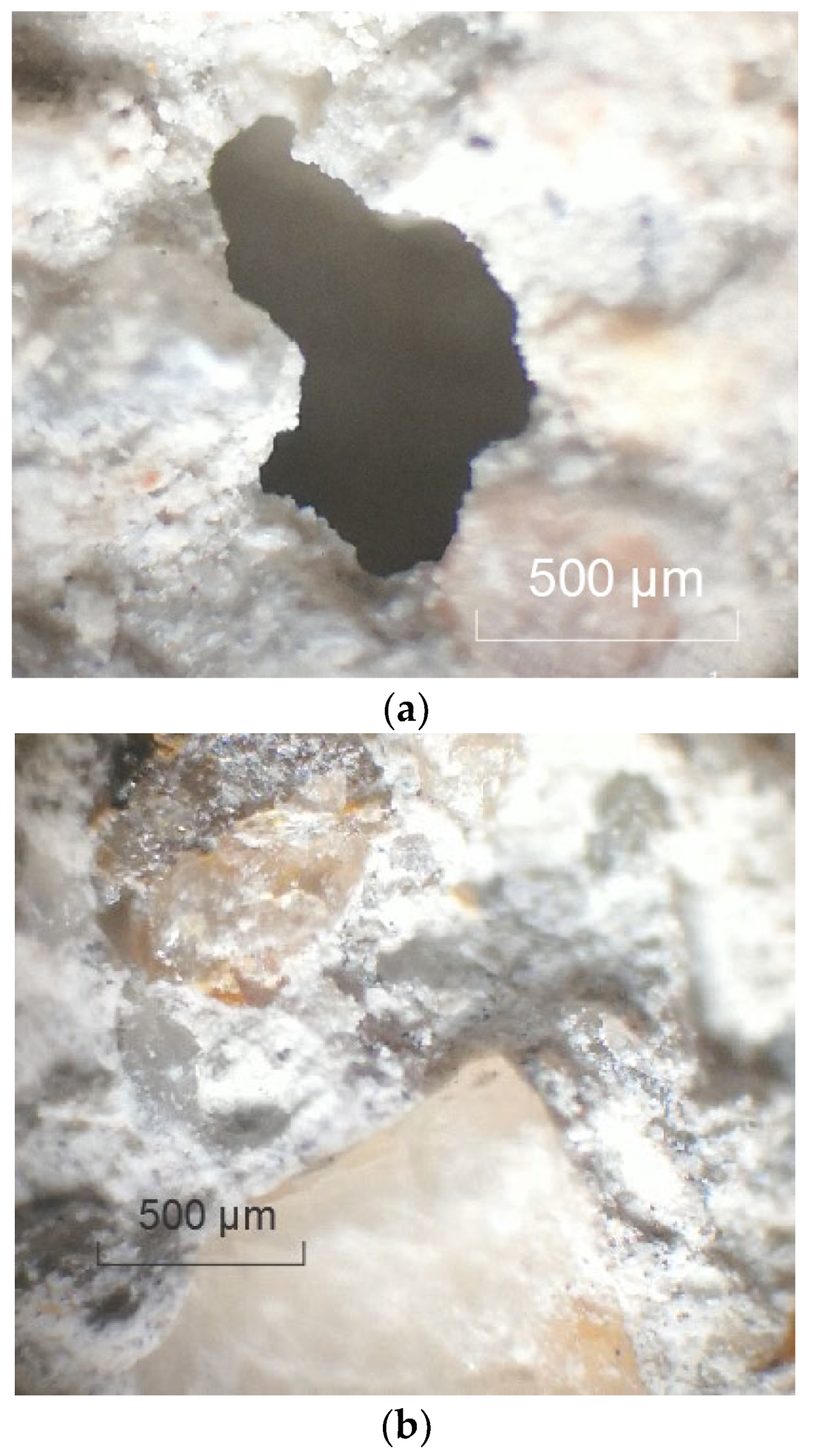
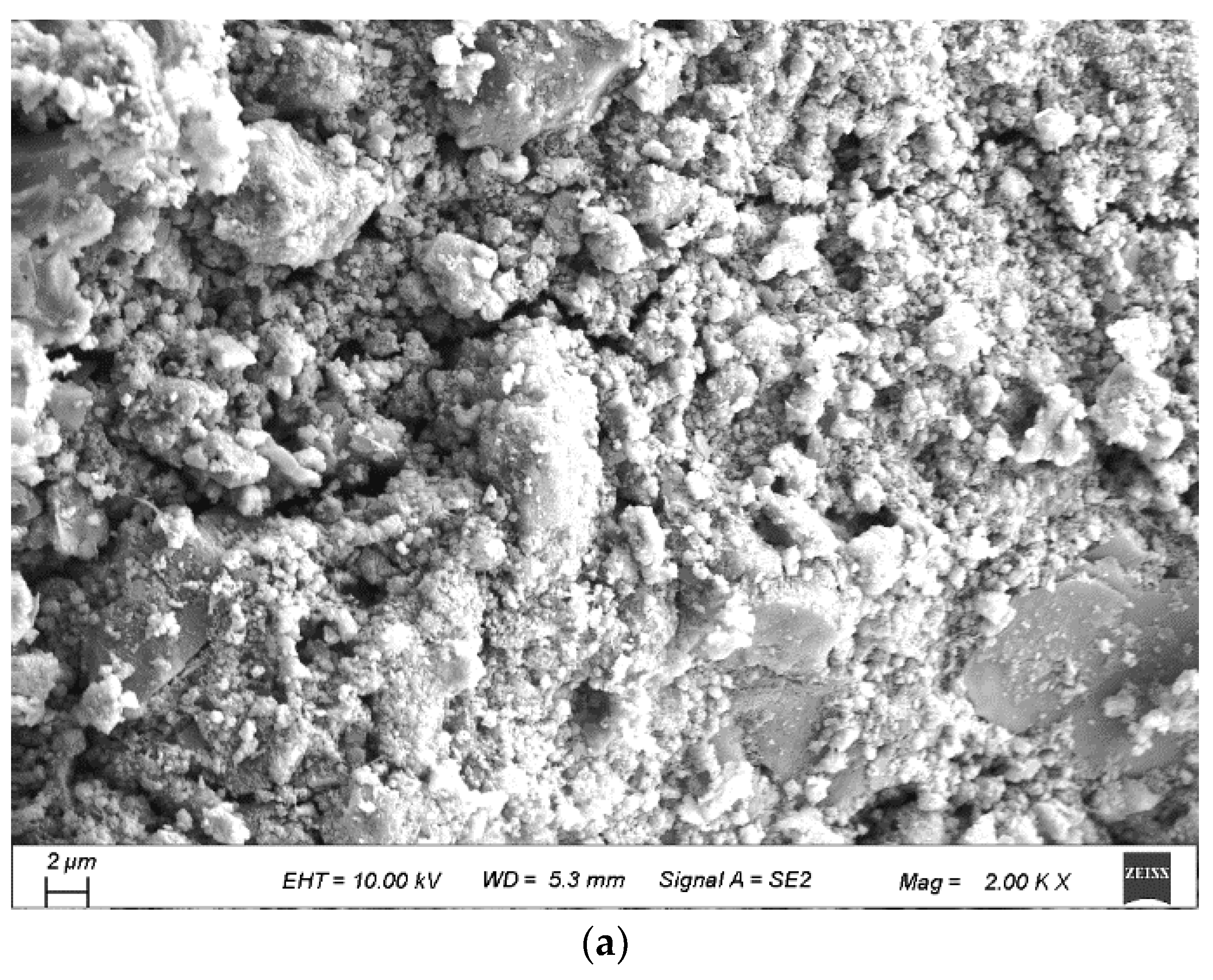
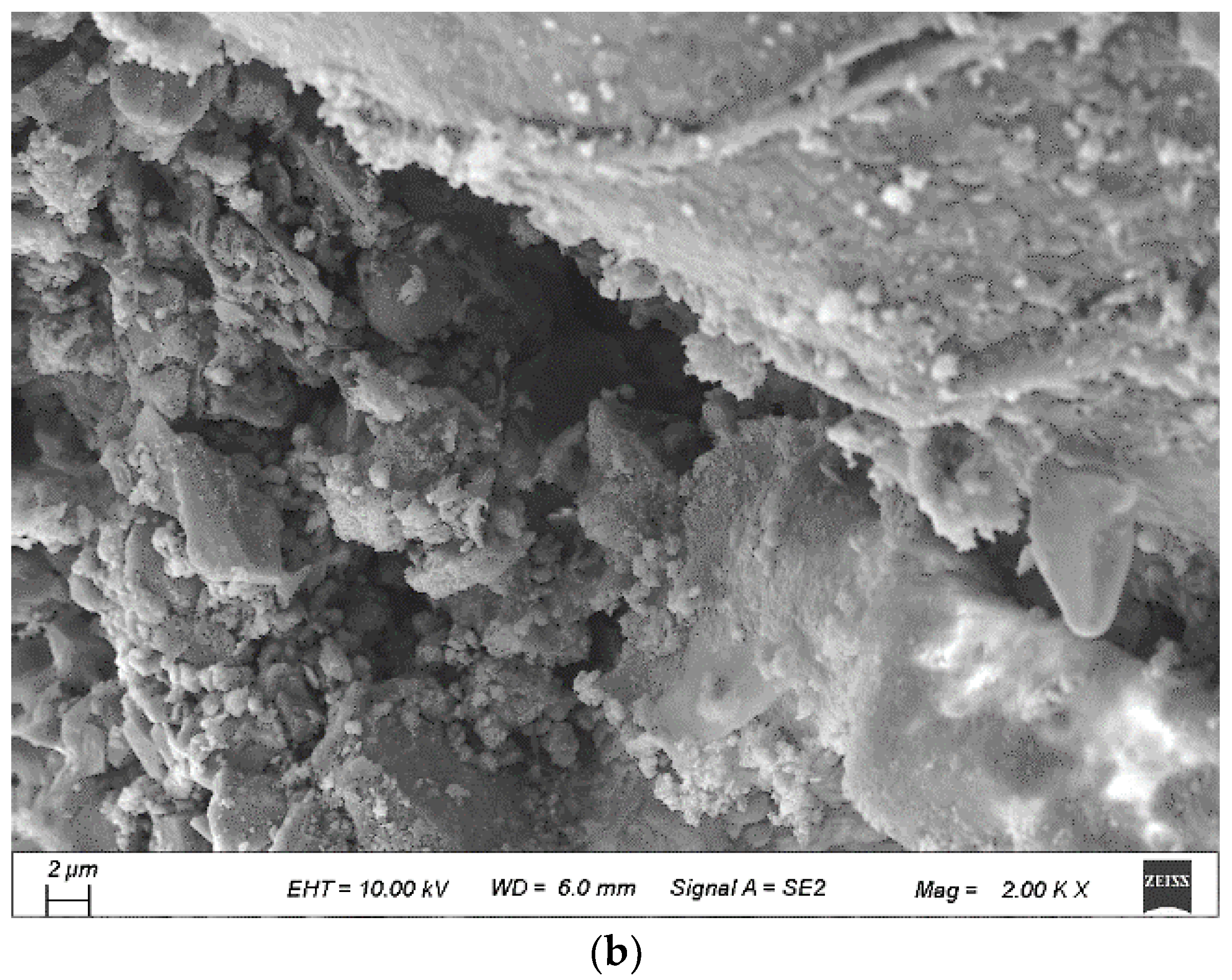
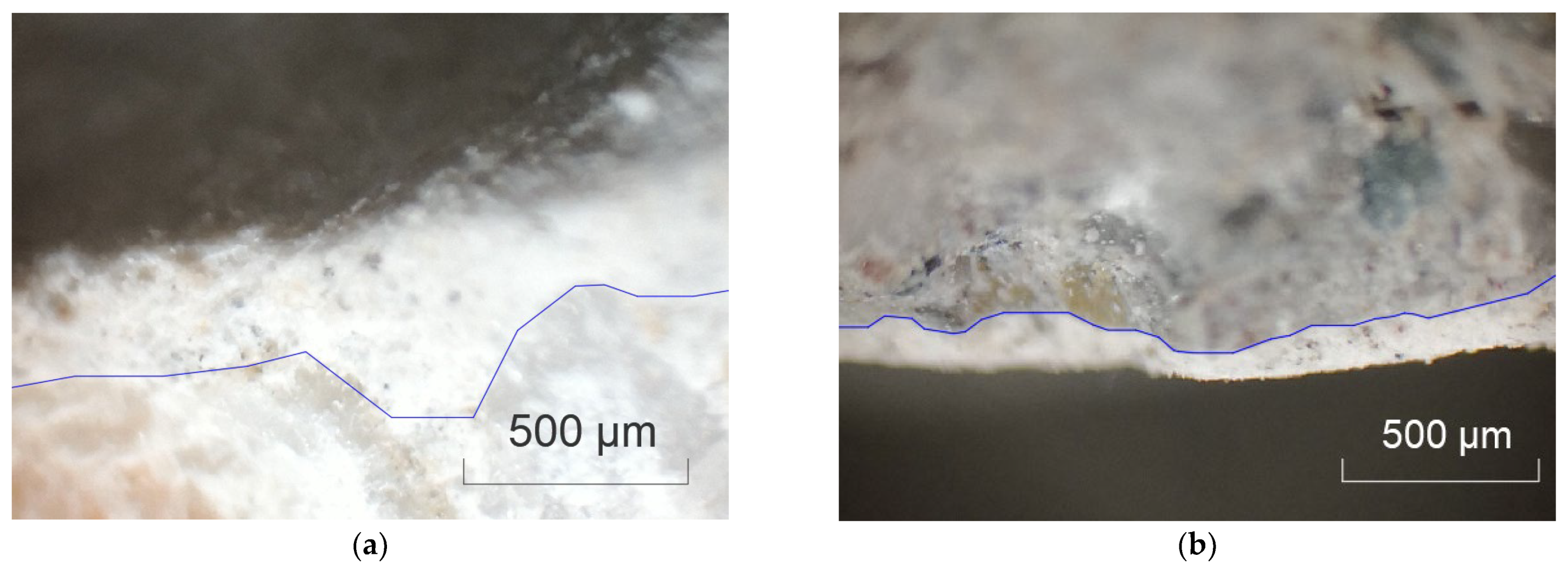


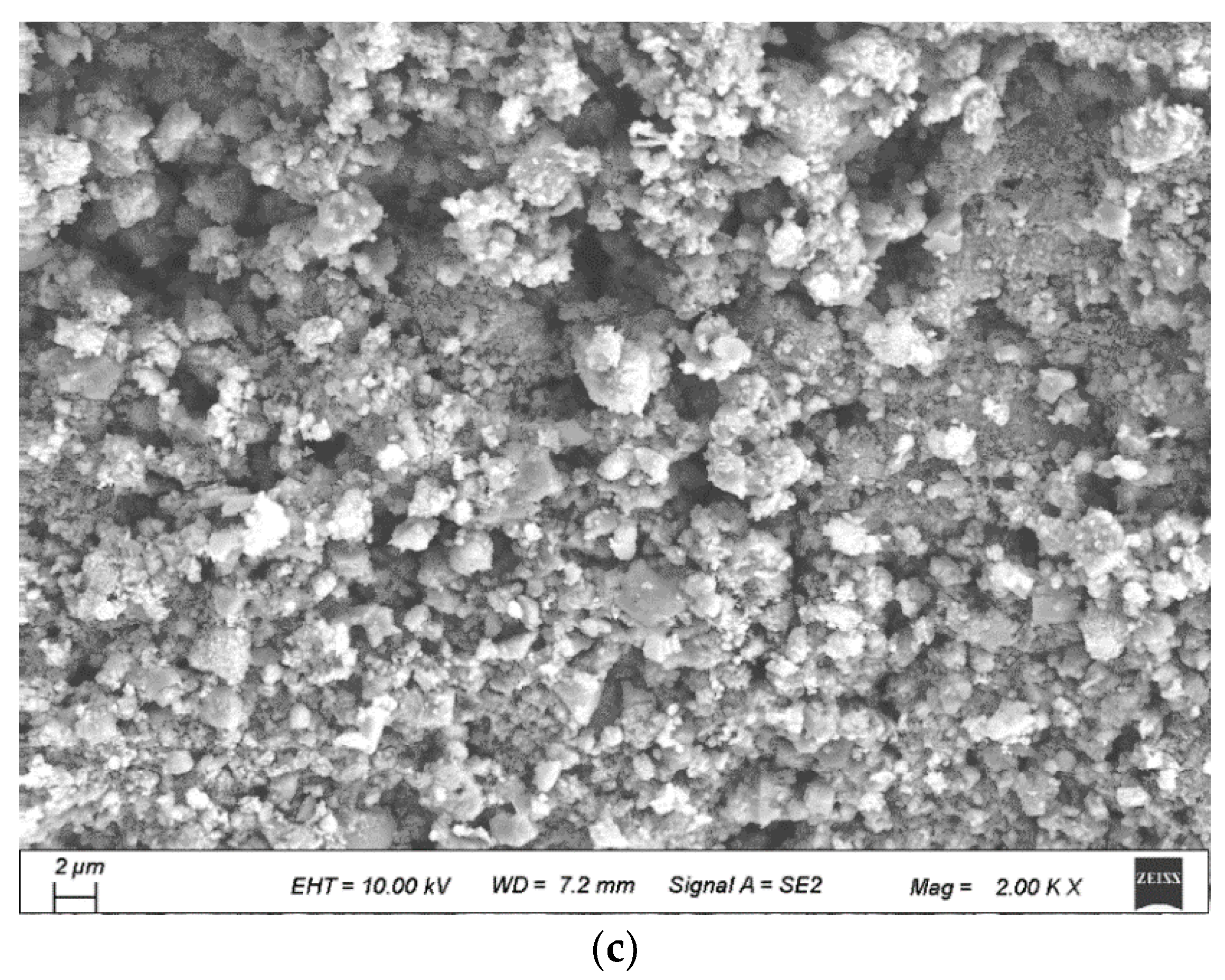
| Property | Apparent Density (kg/m3) | Water Absorption (%) | Crushing Value (%) | Soundness (%) | Particle Size (mm) |
|---|---|---|---|---|---|
| value | 2687.3 | 5.81 | 15.27 | 4.9 | 9.5~19 |
| grade | I | III | II | I | - |
| Composition | CaO | SiO2 | Al2O3 | Fe2O3 | MgO | SO3 |
|---|---|---|---|---|---|---|
| Percentage (wt%) | 59.26 | 20.47 | 6.31 | 4.08 | 2.01 | 2.23 |
| Composition | SiO2 | Al2O3 | Fe2O3 | MgO | CaO | Na2O |
|---|---|---|---|---|---|---|
| Percentage | 95% | 1.0% | 0.9% | 0.7% | 0.3 | 1.3 |
| Number | Water to Binder Ratio (W/B) | Binder | Treatment Method | Abbreviation | |
|---|---|---|---|---|---|
| Cement Ratio (wt%) | Silica Fume Ratio (wt%) | ||||
| 1 | 0.7:1 | 100 | 0 | spraying | S_C0.7 |
| 2 | 1:1 | 100 | 0 | spraying | S_C1.0 |
| 3 | 1.3:1 | 100 | 0 | spraying | S_C1.3 |
| 4 | 1:1 | 92 | 8 | spraying | S_CS1.0 |
| 5 | 1:1 | 100 | 0 | immersing | I_C1.0 |
| 6 | 1:1 | 92 | 8 | immersing | I_CS1.0 |
| RCA | First Stage | Second Stage | t2 s | wat2 | SD1 | SD2 |
|---|---|---|---|---|---|---|
| RCA0 | wat = 0.0009 + 0.0336 R2 = 0.995 | wat = 9 × 10−6 + 0.0557 R2 = 0.9598 | 615 | 5.59% | 57.8% | 96.3% |
| S_C0.7 | wat = 0.001 + 0.0301 R2 = 0.996 | wat = 1 × 10−5 + 0.0549 R2 = 0.9831 | 628 | 5.52% | 51.3% | 94.0% |
| S_C1.0 | wat = 0.0009 + 0.0306 R2 = 0.9972 | wat = 2 × 10−5 + 0.0514 R2 = 0.8715 | 559 | 5.19% | 56.9% | 96.4% |
| S_C1.3 | wat = 0.0007 + 0.0295 R2 = 0.9941 | wat = 5 × 10−6 + 0.0484 R2 = 0.9706 | 740 | 4.85% | 59.2% | 97.5% |
| S_CS1.0 | wat = 0.0009 + 0.037 R2 = 0.9933 | wat = 4 × 10−6 + 0.0628 R2 = 0.835 | 829 | 6.29% | 57.8% | 98.3% |
| I_C1.0 | wat = 0.0007 + 0.0324 R2 = 0.9968 | wat = 2 × 10−5 + 0.0529 R2 = 0.9757 | 909 | 5.35% | 55.9% | 92.2% |
| I_CS1.0 | wat = 0.0007 + 0.0424 R2 = 0.9966 | wat = 1 × 10−5 + 0.0589 R2 = 0.9639 | 572 | 5.91% | 67.1% | 93.6% |
Publisher’s Note: MDPI stays neutral with regard to jurisdictional claims in published maps and institutional affiliations. |
© 2022 by the authors. Licensee MDPI, Basel, Switzerland. This article is an open access article distributed under the terms and conditions of the Creative Commons Attribution (CC BY) license (https://creativecommons.org/licenses/by/4.0/).
Share and Cite
Yin, J.; Kang, A.; Xiao, P.; Wu, Z.; Kou, C.; Gong, Y.; Xiao, C. Influences of Efficient Spraying of Cement-Based Slurries on Recycled Coarse Aggregate. Materials 2022, 15, 7730. https://doi.org/10.3390/ma15217730
Yin J, Kang A, Xiao P, Wu Z, Kou C, Gong Y, Xiao C. Influences of Efficient Spraying of Cement-Based Slurries on Recycled Coarse Aggregate. Materials. 2022; 15(21):7730. https://doi.org/10.3390/ma15217730
Chicago/Turabian StyleYin, Jinming, Aihong Kang, Peng Xiao, Zhengguang Wu, Changjiang Kou, Yongfan Gong, and Chenghui Xiao. 2022. "Influences of Efficient Spraying of Cement-Based Slurries on Recycled Coarse Aggregate" Materials 15, no. 21: 7730. https://doi.org/10.3390/ma15217730
APA StyleYin, J., Kang, A., Xiao, P., Wu, Z., Kou, C., Gong, Y., & Xiao, C. (2022). Influences of Efficient Spraying of Cement-Based Slurries on Recycled Coarse Aggregate. Materials, 15(21), 7730. https://doi.org/10.3390/ma15217730









